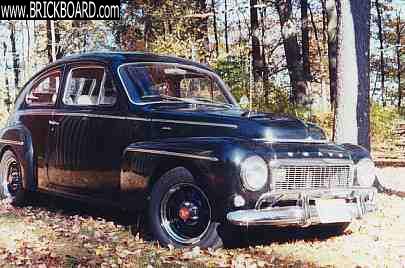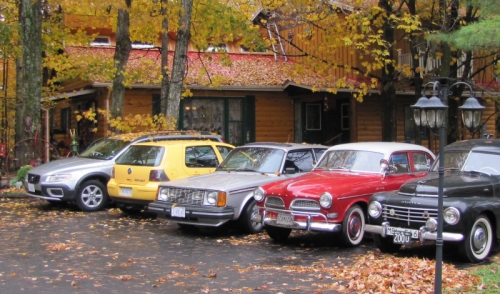|
|
|
The PV tank has a small diameter pickup tube bent down pointing towards the bottom of the tank. I’m concerned that if I pour gas tank sealer into the tank, it will plug the pickup tube. Those who have sealed their before, how did you avoid plugging the pickup tube. The level sender unit opening at the top is very small and does not really allow access to the tube.
Background:
Have the tank out and cleaned it on the outside, found some rust holes. Since the tank was dried out and very rusty, I threw in a chain, added water and agitated it. A lot of rust was washed out.
Next I decided to try electrolysis. I got a large tote and submersed the tank. It’s currently being cleaned. It may take a few days, but the water is already very dirty and I had to clean the anode a few times. When I have a clean anode, it pulls 4 to 6 amps from the battery charger. Over a couple hours the current goes down to nearly zero until I clean the anode again.
So, any ideas on how to keep the pickup tube from being plugged when I finally get to pouring in the sealer?
|
|

|
|
Talking about pickup tubes: since you have invested this much time and effort in the tank already, it may be worth your while to give that pickup tube a close inspection for pitting and/or cracks. You may be able to do that with a mirror and a small flashlight, both on a flexible arms.
After nearly 50 years in place, these tubes tend to show the mentioned defects that lead to perforations which, in turn, affect their ability to take up all the fuel in the tank.
Shortly after acquiring my PV twelve years ago I found myself having to fill up every 100 miles or so. The pick up tube had corroded through about 2.5" above its tip. I unsoldered the tube, cut the tube just above the perforation, soldered on a copper extension, and soldered the tube back into place.
--
‘62 PV544 (B20, M41), '71 142E (Ex-automatic, now carbed), '93 240 Classic Wagon. 
|
|
|
|
|
Thanks for all the feedback, especially the point about the pickup tube. The distance from the tube end to the bottom of the tank seems large, that is a lot of gas would still be left in the tank after your engine starved and stopped.
Anyone know what the distance between the bottom of the tank and the pickup tube should be?
Since there is no screen, if you had large sediments that were pulled in the pipe, it could certainly give you drivability problems whose root cause would be very difficult to resolve.
Thanks for the heads up about the pickup tube being soldered in. I will definitely take it out of the tank for inspection, repair, and while sealing the tank interior.
Plan is to epoxy resin coat the tank, paint it, and spray with chipguard on the outside after repairs and internal sealing.
I know I could get a new tank and just be done with it, but this is a hobby. This is the first time I tried electrolysis, and never sealed a tank from inside before.
|
|

|
|
Anyone know what the distance between the bottom of the tank and the pickup tube should be?
Unfortunately I don't remember with any certainty, but I don't believe I left more than 1/4" between the end of the tube and the tank bottom.
Since there is no screen, if you had large sediments that were pulled in the pipe, it could certainly give you drivability problems whose root cause would be very difficult to resolve.
Tell me about it! The only time my PV has left me stranded was after I, installed a new sender in the tank and, brilliantly, sealed the gasket with silicone-based gasket maker. The silicone softened, swelled up, sloughed off, and got sucked into the fuel line.
I suppose one could finagle some sort of screen over the end of the tube. It would, probably, take a fair amount of dexterity, ingenuity, and patience to bring that off, or, perhaps, a well-trained small monkey. ☺ On the other hand, a filter in the fuel line should take care of most debris problems.
--
‘62 PV544 (B20, M41), '71 142E (Ex-automatic, now carbed), '93 240 Classic Wagon. 
|
|
|
|
|
My pickup tube looks to be more than 1 inch above the tank. The tank being small and the pickup tube leaving a lot of fuel in the tank would significantly reduce range.
I'm still cleaning the tank, but when I'm finished I'll pull the tube for inspection/repair and probably reinstall it somewhere between 1/4 to a 1/2".
|
|
|
|
|
So, I finally completed restoring the gas tank, but I’m not putting it back in the car until I repair the hole in the trunk.
Summary
1. Tank was totally dry and heavy orange rust everywhere inside. The outside looked in good condition.
2. With a length of chain and water inside, agitated the tank and flushed it several times.
3. Next experimented with hydrolysis. Used a tablespoon of Sodium Carbonate (Pool chemical, PH down) to a gallon of water to make the electrolyte. Fully submerged the tank in electrolyte in a large Rubbermaid tote. Attached battery charger ground (negative) to tank. Suspended the Anode rod (positive) from a piece of wood across the tote and inserted it into the electrolyte inside the tank without touching the tank. Turned on the battery charger and observed 4 to 6 amps along with bubbles in the electrolyte. Had this process running for few weeks but had to clean the anode of what appeared to be a rust deposit. The current flow would decrease over time due to the Anode deposit. The electrolyte became very dirty with rust. Flushed the tank with clean water and most of the rust had been removed but not all. Especially the top of the tank. During electrolysis, gas is released and forms pockets at the top of the tank keeping the electrolyte from reacting with the surface.
After cleaning the tank outer surface, found a couple of 1/8” holes. Made a patch from flattened out ½” copper pipe and soldered it in place.
4. Got some Muriatic acid (hydrochloric acid) and mixed it 1 part acid 2 part water. Put the chain and a couple dozen drywall screw in the tank poured in the diluted acid in the tank and sealed it. Agitated the tank about 20 minutes and washed it out. A lot of very rust water came out.
5. After the acid wash, put a little bit of water in the tank and sloshed it around. It became apparent that there were many pin holes. I used a dental pick in the wet areas to push the pick into the tank and enlarge the pinhole so that it was readily visible.
6. Soldered pin holes.
7. Repeated the Muriatic acid cleaning again and a lot more rusty liquid came out. Flushed the tank with water until it was clean. The inside looked like bare metal. Had a few more pin holes, so I soldered them also.
8. Poured in POR15 Metal Ready (Zinc Phosphate) and sloshed the tank around every few minutes allowing a film to form. Without the Zinc Phosphate the inside of the tank would flash rust while drying.
9. Dried out the tank with an industrial heat gun. Left overnight to fully dry.
10. Poured in a quart of the POR15 gas tank sealer and followed instruction on coating the inside of the tank. Then drained the excess gas tank sealer. Left the tank to dry for a week.
11. Next I cover the outside of the tank with epoxy resin, two coats. Looked very nice and shiny.
12. Scuffed the epoxy resin before covering the tank with rubberized undercoating from a rattle spray can.
I know I could have had someone repair the tank or purchased a new one, but that would have been too easy. Besides, if I wanted basic transportation, I would buy a new car from a showroom and just drive it. Sometime the journey is more interesting than your achievements.
|
|
|
|
|
Nice work. I did similar job on my tank last year except I cut out two roughly square holes in the bottom of the tank where the pinholes were, sandblasted the inside (the holes were about 4"X4" so allowed access with a sandblasting gun). I butt welded patches back in, treated with metal-ready and coated with POR gas tank sealer....painted the outside and it looks like new. Like you said, a lot more work than buying a new one but I own it to work on it.
Dean
'61 544
'69 1800
|
|
|
|
|
I used the por-15 gas tank sealer. It is really too 'runny' to clog the fuel line as long as you let the excess drain through the drain plug, I believe the pickup tube drain dry and not plug. To make sure, you can give it a shot of compressed air before while it is draining.
Dean
|
|
|
|
|


